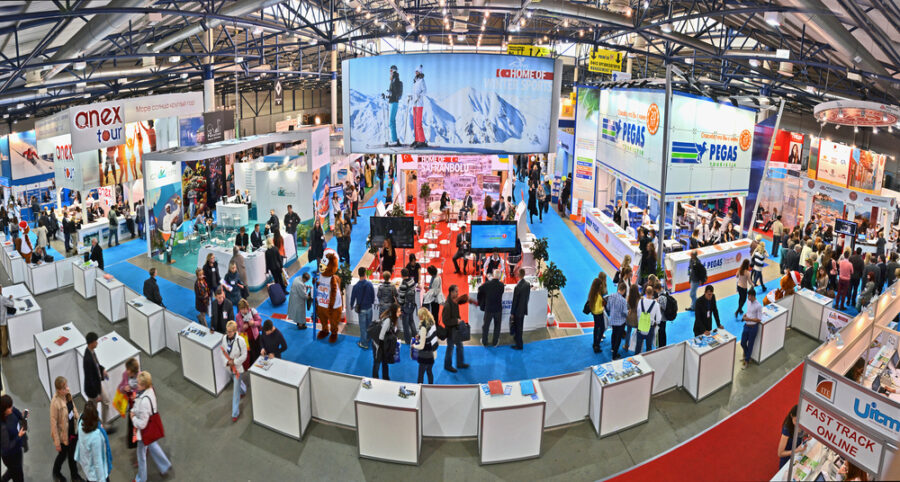





Para emprendedores y pequeñas empresas, participar en una feria o exposición puede parecer un espacio reservado para grandes marcas con presupuestos elevados. Sin embargo, esta percepción es errónea. Las ferias y eventos B2B representan una gran oportunidad para conectar con clientes potenciales y acelerar el proceso de prospección y crecimiento.
Participar en una feria no se trata solo de tener un stand o asistir como espectador; es un ecosistema lleno de oportunidades, donde la clave está en aprovechar cada interacción, cada espacio de capacitación y cada herramienta que las exposiciones ofrecen. Las grandes marcas estarán presentes, sí, pero también puedes tener un lugar destacado si sabes cómo maximizar tu presencia y los recursos disponibles.
Las ferias y exposiciones no son solo para grandes marcas: con estrategia, preparación y tecnología, los emprendedores pueden aprovecharlas para generar clientes, posicionar su marca y acelerar su crecimiento.
Uno de los mayores retos para los emprendedores es conectar de manera efectiva con clientes potenciales. Las exposiciones son, por naturaleza, puntos de encuentro para personas interesadas en las mismas industrias o sectores, lo que crea un entorno ideal para hacer networking.
La clave está en establecer relaciones genuinas que puedan convertirse en oportunidades de negocio reales.
Por ejemplo, durante los 10 shows organizados por RX México en 2024, se realizaron más de 13,000 citas de negocio calificadas que impulsaron nuevas oportunidades comerciales y generaron empleo.
Más allá del networking, las ferias y exposiciones ofrecen una plataforma invaluable para el aprendizaje. Los eventos no solo brindan un espacio para mostrar novedades, sino también una amplia variedad de actividades dedicadas a la capacitación. Desde talleres hasta conferencias y paneles, se puede acceder a contenido educativo de alto nivel.
Uno de los beneficios al participar en una feria es el aumento de la credibilidad. Las exposiciones bien organizadas actúan como vitrinas, donde puedes posicionarte frente a tu audiencia. Para un pequeño negocio, estar presente en un evento no solo significa atraer clientes potenciales, sino proyectarse como una marca seria y profesional dentro del sector.
Es importante reconocer que una exposición no solo se trata de generar leads inmediatos. Muchos negocios se concretan después del evento, cuando los contactos obtenidos se siguen adecuadamente y se utilizan como base para nuevas oportunidades comerciales.
Para aquellos emprendedores que consideran poner un stand, es esencial evaluar si están listos para hacerlo. Algunos aspectos a considerar incluyen su diseño, los materiales promocionales y la preparación del equipo que lo atenderá, ya que es importante que se encuentre bien capacitado y preparado para comunicar con claridad la marca.
Aunque la participación con stand puede parecer costosa, existen opciones de financiamiento y facilidades de pago que hacen que esta inversión sea más accesible. RX México, por ejemplo, ofrece soluciones que ayudan a reducir las barreras de entrada, permitiendo que empresas de diferentes tamaños aprovechen esta plataforma.
Emprendedores y pequeños y medianos empresarios siempre se preguntan cómo pueden destacarse frente a las grandes empresas durante una feria. La respuesta está en aprovechar su agilidad y cercanía con los clientes. Mientras que las grandes marcas pueden enfocarse en marketing masivo, los pequeños empresarios tienen la ventaja de ofrecer un enfoque más personalizado y cercano.
Uno de los grandes temores al participar en una feria es no obtener un retorno de inversión (ROI) positivo. Para medirlo de manera efectiva, es fundamental establecer metas claras antes del evento: ¿buscas generar clientes potenciales?, ¿fortalecer tu red de contactos? o ¿aumentar la visibilidad de tu marca?
Definir indicadores clave de rendimiento (KPIs) te permitirá evaluar si estás alcanzando tus objetivos.
Entre las métricas a considerar están el número de contactos obtenidos, las oportunidades de negocio generadas, el seguimiento posterior al evento y, por supuesto, las ventas cerradas. Evaluar estos resultados te ayudará a saber si tu participación fue rentable y ajustar tu estrategia para futuras ediciones.
Para saber más: ¿Cómo aprovechar las Ferias de Franquicias?
En un entorno donde cada interacción cuenta, la tecnología se ha convertido en una aliada clave para potenciar la participación y los resultados en eventos. Como emprendedor o pequeña empresa, se puede optimizar la presencia, conectar con más personas y convertir contactos en oportunidades reales de negocio, gracias al uso de distintas herramientas.
Participar en una feria no tiene por qué ser una experiencia exclusiva para las grandes marcas. Con una preparación adecuada, un enfoque estratégico y una buena gestión del networking, las oportunidades son vastas y los beneficios, tangibles.







